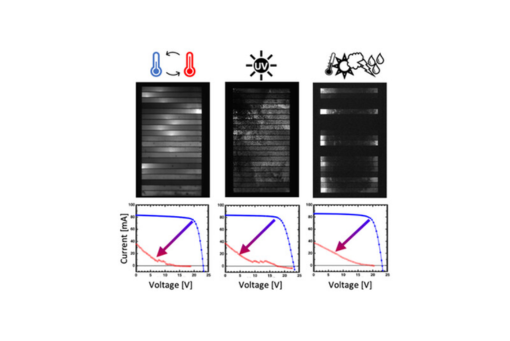Accelerated Stress Testing of Perovskite Photovoltaic Modules: Differentiating Degradation Modes with Electroluminescence Imaging
Abstract
Herein, electroluminescence (EL) and thermal imaging are used to examine p–i–n metal halide perovskite (MHP) photovoltaic (PV) mini-modules (MA0.6FA0.4PbI3, 20 cells, 78 cm2) before and after indoor-accelerated stress testing or outdoor deployment. Distinct spatial patterns in the EL images emerge, which depend on the external stress conditions experienced by the mini-module. Imaging results highlight a distribution of dark speckle features that dominate after UV stress, attributed to widespread interfacial contact degradation. Lateral intensity gradients across cells dominate after thermal cycling (TC) stress, attributed to current crowding near scribe defects. While current–voltage analysis alone does not give full insight on the degradation process, this study shows that distinct degradation modes can be further defined by multimodal electro-optical imaging (i.e., EL combined with photoluminescence and dark lock-in thermography). Neither UV exposure nor TC-accelerated stress testing alone replicates the same degradation signatures observed after outdoor deployment, suggesting that multiple degradation modes occur under concurrent stressors outdoors. Spatial characterization of degradation modes in MHP PV mini-modules before and after accelerated stress testing lays the groundwork for developing targeted accelerated stress testing procedures through comparison with outdoor aging.
Citation
Schall, J. W., Glaws, A., Doumon, N. Y., Silverman, T. J., Owen-Bellini, M., Terwilliger, K., Uddin, M. A., Rana, P., Berry, J. J., Huang, J., Schelhas, L. T., & Kern, D. B. (2023). Accelerated stress testing of perovskite photovoltaic modules: Differentiating degradation modes with electroluminescence imaging. Solar RRL. https://doi.org/10.1002/solr.202300229


